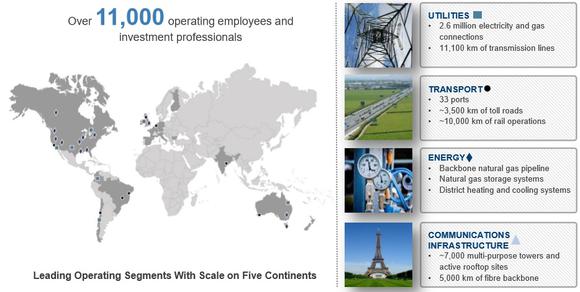
Source: Brookfield Infrastructure Partners.
Long-term investors know that after a strong rally as we've had over the past few months, higher valuations can result in future underperformance.

BIP Total Return Price data by YCharts
The same is true with utility stocks such as Brookfield Infrastructure Partners (BIP +0.77%), National Grid plc (NGG +1.83%), Exelon (EXC +1.05%), Dominion Resources (D +1.31%), and Sempra Energy (SRE 1.36%).
However, only some of these utilities have enjoyed strong price appreciation during this rally. So does this mean Dominion Resources and National Grid are likely to outperform their higher-flying peers? Not necessarily. In fact, even though its price rocketed skyward over the past two months, Brookfield Infrastructure Partners is the one for high-yield investors to consider over its rivals. Read on to find out why.
Brookfield Infrastructure offers something its competitors lack
Long-term dividend sustainability is usually the most important factor to high-yield investors, and diversification of cash flows is a great way to enhance payout security.
All of Brookfield Infrastructure's competitors have at least some diversification baked into their business models. For example, National Grid owns a dominant position in both natural gas and electricity in its native UK, as well as an electric distribution network in New England.
The combination of natural gas and electric distribution is also a common characteristic for Sempra Energy, Exelon, and Dominion Resources.
Exelon also boasts power diversification through its low-carbon fleet of hydroelectric dams, nuclear power plants, and growing solar and wind businesses. And like National Grid, Sempra Energy has cross-national diversification thanks to its Mexico energy generation and distribution segment. However, none of these utilities can hold a candle to the kind of global, multi-industry diversification Brookfield boasts.

Source: Brookfield Infrastructure Partners presentation.
However, diversification is just one reason Brookfield is such an attractive long-term investment. Unlike its larger competitors, Brookfield Infrastructure isn't just a high-yield stock; it's also a dividend growth standout.
Superior payout growth usually results in better long-term returns

BIP Total Return Price data by YCharts
Over the past eight years, Brookfield Infrastructure and Sempra Energy have crushed their competitors when it comes to dividend growth. Yet Brookfield Infrastructure Partners still returned stronger total returns thanks to its much higher yield of 5.3%, compared to Sempra's 2.9%.
While past performance is no guarantee that Brookfield will continue outperforming competitors and the market in the future, there are several reasons I believe this superior payout trend will continue.
For one thing, Brookfield Infrastructure has access to much better growth opportunities than its rivals, who operate in much more mature and developed markets.
In addition, when it comes to free cash flow, the thing that ultimately pays for dividends, Brookfield Infrastructure proves far superior to these other four utilities. In fact, here are their free cash flow margins (operating profits minus capital expenditures on maintenance and growth as a percentage of annual revenue). Note that Brookfield's equivalent metric is called adjusted funds from operations.
- Brookfield Infrastructure Partners: 36.2%
- National Grid: 5.9%
- Exelon: 0%
- Sempra Energy: -7.6%
- Dominion Resources: -9.4%
While Dominion Resources, Sempra Energy, and Exelon didn't generate positive free cash flow in 2015, that doesn't necessarily mean their dividends are unsustainable. It's merely a reflection that each utility invested a greater than average amount into capital projects in 2015.
However, the preceding comparison makes it clear that Brookfield Infrastructure is a free cash flow machine, which bodes well for investors, given management's 11% to 13% payout growth forecast for 2016, with 9% growth projected in 2017 and 2018.
Superior profitability shows strong management discipline
| Utility | WACC | ROIC | Net ROIC |
|---|---|---|---|
| Brookfield Infrastructure Partners | 5.75% | 11.04% | 5.29% |
| National Grid | 4.15% | 8.72% | 4.57% |
| Dominion Resources | 2.93% | 6.07% | 3.14% |
| Sempra Energy | 5.19% | 5.59% | 0.40% |
| Exelon | 2.47% | 6.85% | 4.38% |
Source: GuruFocus.
Despite having the highest weighted average cost of capital, Brookfield Infrastructure Partners has a higher net return on invested capital (ROIC-WACC) than its peers.
That means that whether obtaining growth capital from debt or equity markets, Brookfield's management, thanks to its disciplined approach to buying quality assets at highly attractive prices, is able to put investor capital to work more profitably than other, larger utilities.
That's largely thanks to the superb experience of its management team, provided by its sponsor, Brookfield Asset Management, one of the world's premier managers of infrastructure and utility assets.
Brookfield Asset Management has over 100 years of global experience, providing Brookfield Infrastructure with some truly remarkable investment opportunities. For example, the utility is currently considering additional Brazilian and other South American assets, which are going for fire-sale prices thanks to the region's recession, a result of the commodity price collapse.
Risks to watch for
Global diversification that provides superior growth markets across various fast-growing industries can also act as a double-edged sword.
For instance, because it operates across five continents, Brookfield's cash flows are exposed to the vagaries of changing exchange rates. In addition, the same economic challenges that allow it to invest new capital so profitably in some depressed regions also means that a small percentage of cash flows from those areas not protected by long-term contracted prices or volume commitments might ding short-term AFFO.
Bottom line
I'm not saying that these other utilities aren't worth owning in your diversified high-yield portfolio. However, because of its superior profitability, vast global diversification, and faster probable long-term payout growth, Brookfield Infrastructure deserves to be on every high-yield investor's radar, despite the recent price rally.